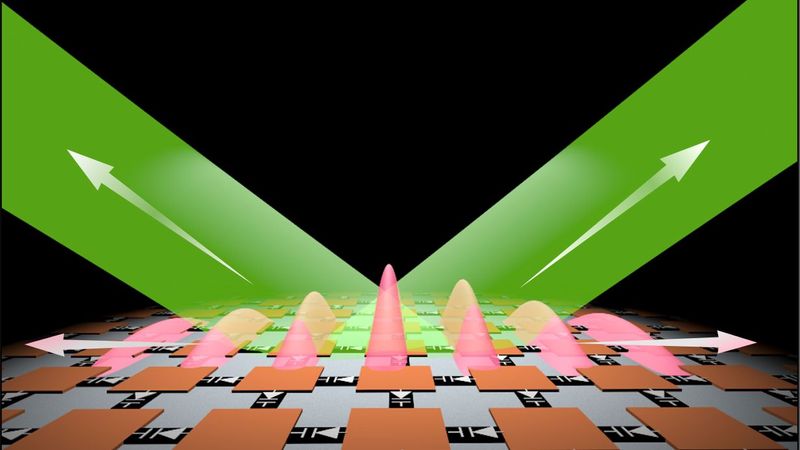Metamaterials: Time Crystal Gets Light Going
Photonic time crystals, whose properties change periodically, promise significant advances in microwave technology, optics and photonics. Researchers at the Karlsruhe Institute of Technology (KIT), together with partners at Aalto University and Stanford University, have now produced a two-dimensional photonic time crystal for the first time and demonstrated important applications.

A 2D photonic time crystal can amplify free space and surface waves. (Graphic: Dr. Xuchen Wang, KIT)
Photonic time crystals, whose properties change periodically, promise significant advances in microwave technology, optics and photonics. Researchers at the Karlsruhe Institute of Technology (KIT), together with partners at Aalto University and Stanford University, have now produced a two-dimensional photonic time crystal for the first time and demonstrated important applications. Their approach simplifies the production of photonic time crystals and can improve the efficiency of future communication systems.
In the broadest sense, time crystals belong to the so-called metamaterials, which are artificially produced and have properties that do not occur in nature. In 2012, the physics Nobel Prize winner Frank Wilczek presented the fascinating concept of time crystals for the first time. Unlike ordinary crystals, time crystals do not change their properties in space, but periodically in time. Photonics researchers are currently working on the first optical versions of these materials, known as photonic time crystals. These crystals have great potential for improving wireless communication signals and may enable a new generation of lasers in the future, as light propagating in photonic time crystals can be effectively amplified.
Reduction of dimensionality facilitates realization
So far, research in the field of photonic time crystals has focused on bulk materials, i.e. three-dimensional structures. However, the realization of photonic time crystals in such materials represents an enormous challenge and the experiments have so far not gone beyond model systems. Practical applications of these three-dimensional structures have not yet come about. Researchers from the Institute of Nanotechnology and the Institute for Theoretical Solid State Physics (TFP) of KIT, together with partners from Aalto University in Finland and Stanford University in the USA, have now developed a new approach and presented it in the journal Science Advances: The team has one for the first time two-dimensional photonic time crystal. It is a very thin layer of such metamaterial. “We have found that reducing the dimensionality from a 3D to a 2D structure greatly simplifies implementation. This made it possible to realize photonic time crystals," explains Dr. Xuchen Wang, the main author of the study, who is currently conducting research at KIT in the group of Professor Carsten Rockstuhl at the TFP. The team designed and synthesized a two-dimensional electromagnetic structure. This contains tunable components periodically embedded in time that change their electromagnetic properties. By using this structure, it was possible to experimentally confirm the theoretically predicted behavior.
Photonic time crystals in 2D make communication more efficient
The pioneering development enables advances in various technologies, such as wireless communication, integrated circuits and lasers. By amplifying electromagnetic waves, wireless transmitters and receivers can become more powerful and efficient in the future. In addition, coating surfaces with two-dimensional photonic time crystals can reduce signal dropout in wireless transmission. This often represents a bottleneck. The use of two-dimensional photonic time crystals can also simplify the construction of lasers in the future, since complex mirror systems, such as those normally used in laser resonators, are no longer required.
Another important application arises from the realization that photonic time crystals in 2D amplify not only the incoming free-space electromagnetic waves, but also surface waves, which are used for communication between electronic components in integrated circuits. Surface waves suffer from absorption losses in the material, reducing signal strength. "By using two-dimensional photonic time crystals covering the propagation medium, the surface acoustic wave can be amplified, which improves communication efficiency," says Wang.
Original publication
Xuchen Wang, Mohammad Sajjad Mirmoosa, Viktar S Asadchy, Carsten Rockstuhl, Shanhui Fan, & Sergei A Tretyakov: Metasurface-Based Realization of Photonic Time Crystals. Science Advances, 2023. DOI: 10.1126/sciadv.adg7541